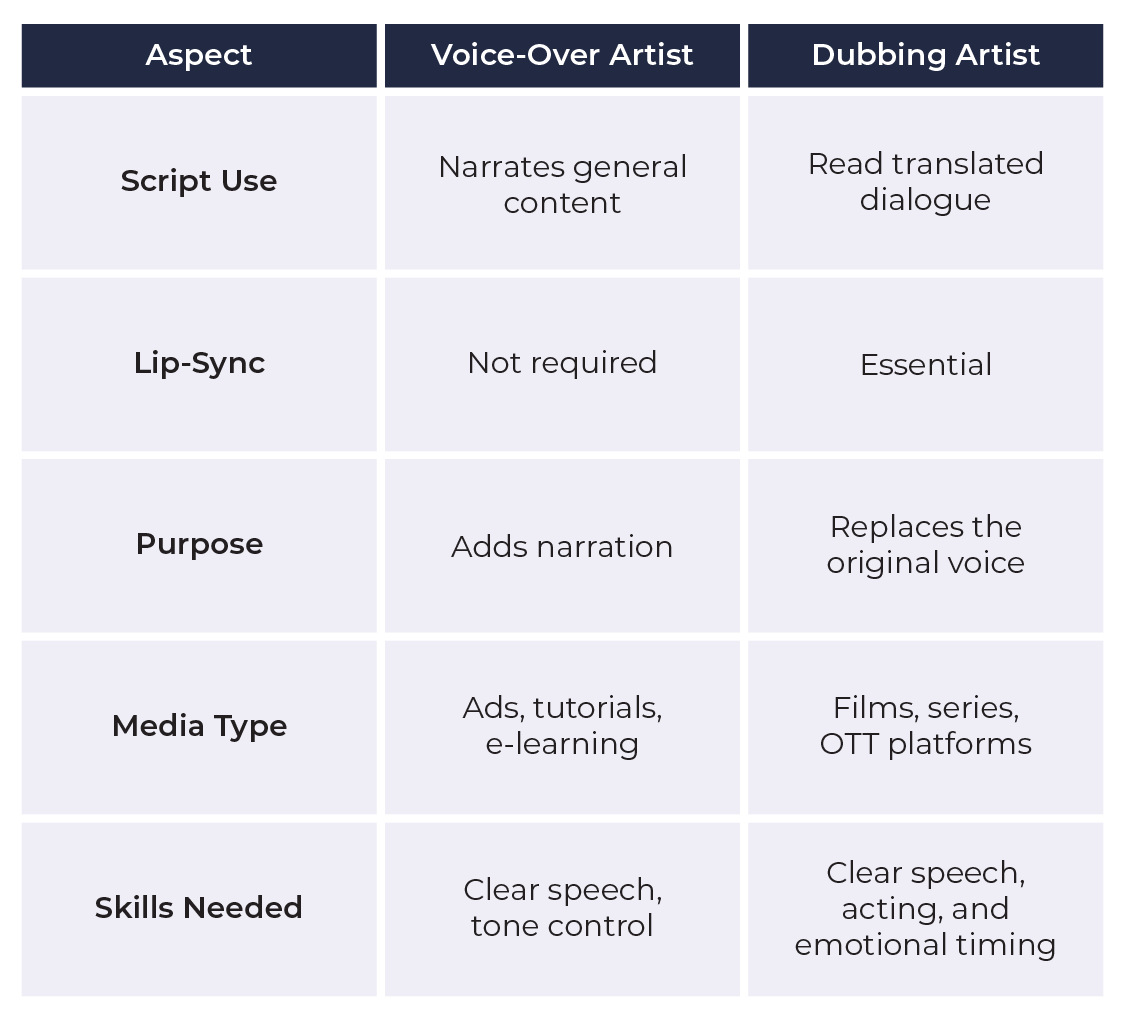Voice-over artist and dubbing artist jobs are often confused as the same profession. They are not the same. A voice-over artist is one who narrates in videos without syncing lips. Dubbing artists substitute original speech in movies and programs and synchronise with the mouth movements. The two professions are found in the audio production sector, but they require varying skills and preparation. Learning these differences can assist individuals in deciding whether to pursue a career as a voice-over artist career and dubbing artist career path.
What Is a Voice-Over Artist?
A voice-over artist reads and recites scripts in various productions in the media. Their voice is recorded independently of the video, and they do not require synchronising the video lip movements.
- Used in e-learning courses, advertisements, and corporate training videos
- Works in English and regional languages, depending on the project
- Reads clearly, adapts tone to match content, and follows written scripts exactly
The voice-over artist job market has several positions, such as educational companies, marketing firms, and the Internet. Individuals venturing into a voice-over artist career often start with smaller jobs and then proceed to larger commercial work.
What Is a Dubbing Artist?
A dubbing artist substitutes the original or natural spoken audio of films, television shows, or web-based materials. They have to synchronise voice time with the movements of the lips of actors on the screen. It requires precise timing and good language skills.
- Used in translated films, anime series, and streaming platform content
- Must match lip-sync perfectly while maintaining the original emotional tone
- Requires fluency in multiple languages and excellent timing skills
With the rise of streaming, dubbing artists’ work has increased considerably. A dubbing artist’s career involves collaboration with translation groups and directors to achieve accurate voice replacement. The dubbing artist’s job requires both technical precision and acting ability.
Key Differences Between Voice-Over and Dubbing
While both professions use voice as the main tool, their methods and goals differ:

Voice-Over Artist Career Path
Starting a voice-over artist career requires specific training and practice. The field offers multiple entry points for people with different experience levels.
- How to become a voice-over artist: Take professional voice training courses and practice reading scripts daily
- How to get started as a voice actor: Create a professional demo reel and submit applications to talent agencies
- How do I become a voice actor with no experience: Start with small online projects or volunteer work to build a portfolio
- Explore both freelance opportunities and studio-based voice-over artist job openings through industry websites
Building a successful voice-over artist career takes time and consistent effort. Many professionals start part-time while developing their skills and client base.
Dubbing Artist Career Path
Entering a dubbing artist career requires specialised training in synchronisation and language skills. The field demands technical precision and cultural understanding.
- Take professional language training to master pronunciation and cultural nuances
- Practice matching voice delivery to existing video content using sample scenes
- Record sample dubbed scenes to demonstrate timing and emotional range abilities
- Search for dubbing artist work opportunities at local studios and production companies
A dubbing artist’s career often begins with smaller projects or background voices before advancing to main character roles. Studios typically prefer artists with proven synchronisation skills and language expertise.
Shared Skills and Tools Between Voice-Over and Dubbing Artists
Both professions require similar foundational abilities and equipment knowledge. These shared skills form the basis for success in either career path. These shared skills form the basis for success in either career path within film production employment:
- Clear pronunciation and articulation for professional audio quality
- Familiarity with studio recording equipment and software programs
- Ability to adapt voice tone and emotion to match project requirements
- Strong script-reading skills with proper pacing and emphasis
- Basic audio editing knowledge for self-directed recording sessions
These core competencies apply to both the voice-over artist and dubbing artist work environments.
Salary and Demand
Both careers offer competitive compensation with growth potential based on experience and specialisation.
- Voice-over artist: Entry-level rates range from $20 to $80 per hour, with experienced professionals earning significantly more per project
- Dubbing artist: Payment typically occurs per episode or film project, with rates varying based on language pairs and production budget size
The entertainment industry’s growth drives opportunities in both the voice-over artist job and dubbing artist job markets.
Learning and Certification
Professional training options exist for both career paths through various educational platforms and institutions.
- Voice-over Training: Online voice coaching programmes, acting workshops focusing on vocal performance, and specialised narration technique courses provide foundational skills.
- Dubbing Training: Studio-based training programmes teach synchronisation techniques, language-specific pronunciation coaching, and timing coordination methods.
- Educational Platforms: Coursera, Udemy, and Skillshare offer beginner to advanced courses in both voice-over and dubbing techniques.
- Institutional Programs: Media colleges and performing arts schools provide comprehensive voice and dubbing workshop programmes with hands-on studio experience.
Many professionals combine online learning with in-person coaching for comprehensive skill development.
Conclusion
A voice-over artist creates narration without synchronising to lip movements, while a dubbing artist replaces existing dialogue while matching mouth movements precisely. Both roles contribute to the growing voice and dubbing industry and are part of the wider range of jobs in the film industry. Those interested in narrating educational content or localising international films will find that both career paths offer growing market demand and accessible entry-level opportunities for dedicated professionals.








